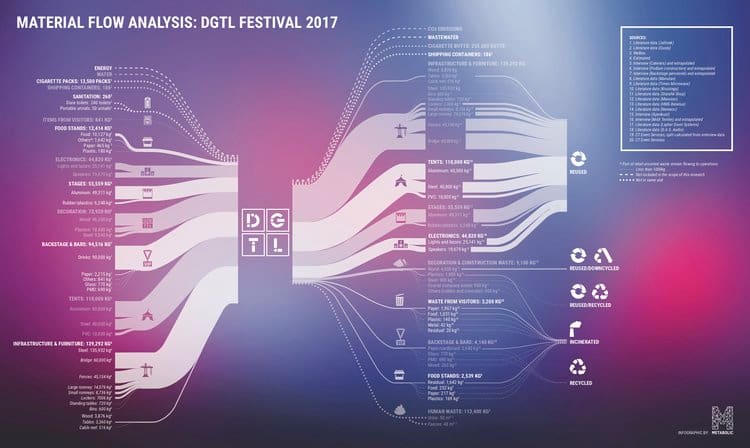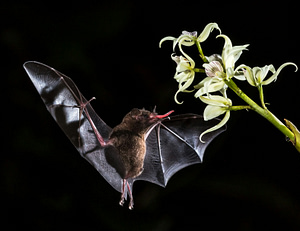Drawing on her work with DGTL and Welcome to the Village festivals, Nadina Galle shares her top-five guidelines on achieving circular economy at the festival level.
Festivals are essentially cities. Hosting thousands (and sometimes tens or hundreds of thousands) of people, festivals can even exceed the population of the city they’re hosted in. Unlike cities, festivals are temporary in nature and are built up every year for just a couple of days. This rapid construction and demolition make them interesting case studies for circular design, responsible upcycling, and waste-free strategies. But festivals offer a whole lot more than just infrastructure, of course – they are epicentres of music, entertainment and food. All of that requires facilities in the form of electricity, water, sanitation, catering, and shelters.
At the same time, their temporary nature, often autonomous way of working, and quick-turnaround make them the ideal playground for circular innovations. But to understand which innovations make most sense and where, we must understand the dynamics within a festival’s ecosystem. Only then will we gain key insights into the structural root causes of impacts and identify the interventions necessary to transition these unique systems.
These are my top-five guidelines for how to create a circular festival:
1.Know your (resource) flow
A baseline assessment is the first step to understanding any system. To do this, we use a ‘material flow analysis’ (also known as an MFA), which provides a detailed assessment of the flows and levels of materials within a ‘system’. A festival is an ideal system to examine as it is defined in a specific space and time – it is temporary and its boundaries clearly sectioned off (often with an actual gate around the festival grounds). These boundaries make it easy to define exactly what comes out and what comes in, offering an accurate account of what materials are having the most impact and where you can make the most positive changes. An analysis of this kind is not only an interesting snapshot of your festival, but a crucial step to take when transitioning to circularity.
2.Matching source separation and centralized separation of waste
Waste management must go hand in hand with procurement. The bar manager, who buys in all wines in PET bottles (for example), should talk to the waste management team to ensure they can accept these. Each festival, but most importantly, each city or region which they’re hosted in has different ways to process waste. Some cities opt for source separation, others collect unsorted wastes. Whatever method, the festival should find ways to complement these. To ensure proper reuse, recycling and waste processing of everything that is coming in to the festival, it is imperative to understand where your waste is ending up. Think further than just the festival grounds to ensure the festival is becoming circular both on, and off, the festival grounds.
3.Be wary of biodegradables
Several Dutch festivals, including DGTL and Welcome to the Village, have made big strides by eliminating single-use cups and replacing them with their hard cup counterpart. These offer less plastic waste, a cleaner festival terrein, and most importantly, they keep your beer colder longer. To complement the sustainability wins for beverages, festivals have looked to food and some have implemented mandatory rules on caterers to only serve their food with biodegradable utensils and food containers. Besides increasing costs for caterers, biodegradable materials might not be as sustainable as they seem. In fact, most end up in the incinerator, regardless of their potential. And even if they are collected separately and then used for the production of biogas, this use is not the most circular “use” of this nutrient-rich raw material. The best, and most truly circular option, is to return these nutrients into the biological cycle by composting them and returning them to the soil. To do that, efficient collection must be implemented.
4.Watch out for embodied impacts
Metabolic’s definition of a circular economy goes beyond materials. We’ve defined it as a new economic model for addressing human needs and fairly distributing resources without undermining the functioning of the biosphere or crossing any planetary boundaries. What this means is that the system should also be based on renewable energy, be resilient, and structurally support key parameters of planetary health such as biodiversity, health and wellbeing, and culture and society. As a festival, one can make critical choices in the location, accessibility, mobility options, catering, beverages, and power supply to have a positive influence on not only the local environment, but also to avoid embodied impacts on land use, water and CO2 emissions.
5.Responsible upcycling
To reach circularity ambitions, festivals may turn to upcycling as a way to reduce raw material use. However, sometimes products can be upcycled in irresponsible ways. An example of this is the use of recycled plastic for furniture on festival grounds. Although these projects are often well-intentioned they are often “downcycling-in-disguise” where materials are recycled in a way they retain a lower value than what they were. Even an upcycled product will reach the end of its life, and when it does the problem often lies in the irreversible combining of materials, such as by using adhesives, which are hard to take apart at the end of the product’s life span. Otherwise, you may produce a “dead-end” in the material cycle. Products should be designed for disassembly so the materials can always be reused.. Whatever you’re designing, remember to avoid using critical or scarce materials, such as gold or copper, to protect them for future generations. Last but certainly not least, make sure to check the toxicity of the original materials you’re upcycling (such as the combination of PVC-materials) to ensure there is no unintentional and potentially dangerous exposure.
Follow these guidelines and we can transition to a circular economy in a safe, just, and above all innovative way. Yet, to move towards a circular state, everyone on a festival production team has to be on board. It requires everyone from the technical producer, to the caterers, to the artists, to the sanitation guy, to come together and ensure the festival is embracing circularity in a way that makes contextual sense for them.
Want to know more? Head here for our Welcome to the Village report [Dutch] and here for the DGTL report [Dutch]. For more information feel free to contact Nadina Galle.







